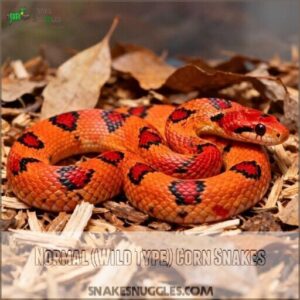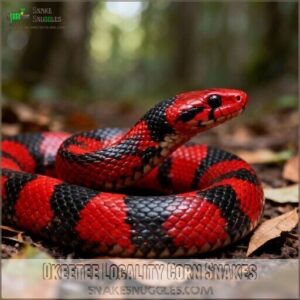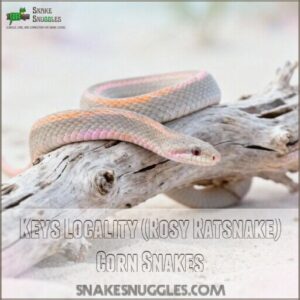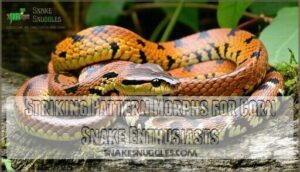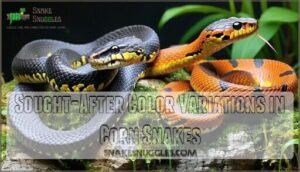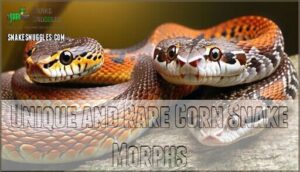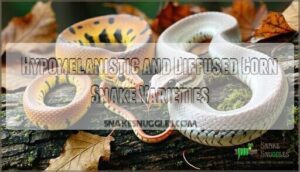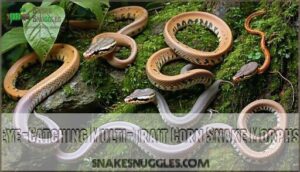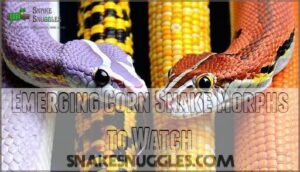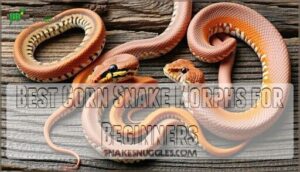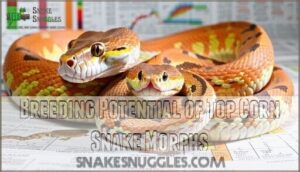This site is supported by our readers. We may earn a commission, at no cost to you, if you purchase through links.
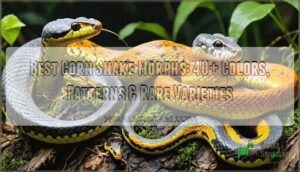 A corn snake breeder once told me the hardest part isn’t breeding the snakes—it’s choosing which morph to work with first. With over 800 documented corn snake morphs and more appearing every year, the options can overwhelm even experienced keepers.
A corn snake breeder once told me the hardest part isn’t breeding the snakes—it’s choosing which morph to work with first. With over 800 documented corn snake morphs and more appearing every year, the options can overwhelm even experienced keepers.
Some morphs flash neon oranges and candy-apple reds, while others sport pearl whites or smoky charcoals. Pattern mutations turn classic saddles into stripes, tessellations, or completely solid bodies. The genetics behind these variations follow predictable rules, which means you can plan breeding projects that stack multiple traits into stunning combinations.
Whether you’re after classic Okeetees with bold black borders or rare Palmettos covered in random speckles, understanding which morphs deliver the best visual impact, breeding potential, and market value helps you make smart choices.
Table Of Contents
- Key Takeaways
- Top-Rated Classic Corn Snake Morphs
- Most Popular Albino and Amelanistic Varieties
- Striking Pattern Morphs for Corn Snake Enthusiasts
- Sought-After Color Variations in Corn Snakes
- Unique and Rare Corn Snake Morphs
- Hypomelanistic and Diffused Corn Snake Varieties
- Eye-Catching Multi-Trait Corn Snake Morphs
- Emerging Corn Snake Morphs to Watch
- Best Corn Snake Morphs for Beginners
- Breeding Potential of Top Corn Snake Morphs
- Frequently Asked Questions (FAQs)
- What is the most popular corn snake morph?
- What is the perfect corn snake enclosure?
- What is a ghost corn snake?
- What is the orange morph corn snake?
- How do corn snake morphs affect behavior?
- Are certain morphs more prone to health issues?
- What is the price range for different morphs?
- How do morphs impact the snakes lifespan?
- Are there any legal restrictions on owning morphs?
- How long do corn snakes typically live?
- Conclusion
Key Takeaways
- Corn snake morphs span over 800 varieties created through predictable genetic patterns, letting breeders stack multiple traits to produce specific color and pattern combinations worth $40 to over $4,000 depending on rarity.
- Classic morphs like Normal, Okeetee, and Albino provide affordable entry points ($40-$150) with hardy genetics and beginner-friendly care, while rare morphs like Palmetto and Scaleless command premium prices but may carry health risks.
- Pattern mutations (Tessera, Motley, Striped) and color variations (Lavender, Caramel, Charcoal) work through recessive or dominant inheritance, allowing breeders to calculate offspring outcomes using Punnett squares before pairing snakes.
- Multi-trait morphs combining two or more genetic mutations (Snow Tessera, Plasma, Opal) create the most visually striking specimens, though ethical breeding requires avoiding problematic combinations that cause neurological issues or shortened lifespans.
Top-Rated Classic Corn Snake Morphs
Classic corn snake morphs are where it all started. These are the foundation morphs that breeders have worked with for decades.
Let’s look at four classic varieties that remain popular among keepers today.
Normal (Wild Type) Corn Snakes
The Normal corn snake is where the magic all began—the foundation morph that every other variety traces back to. These wildtype beauties showcase the natural habitat colors that helped their ancestors thrive in the wild. You’ll see orange base tones with red blotches outlined in black—the classic look that made corn snakes famous.
What makes Normal Corn Snake Morphs ideal for beginners:
- They’re affordable at around $40
- Their beginner friendliness is unparalleled with easy care requirements
- Wild-type genetics mean vigorous health and predictable traits
Identifying normals is straightforward once you recognize those distinctive earthy patterns.
Okeetee Locality Corn Snakes
If you want something that takes the classic corn snake look and cranks up the contrast, Okeetee locality snakes are your answer. These corn snake morphs show off vivid red saddles wrapped in thick black borders. Wild Okeetees from South Carolina started this trend.
Now captive breeding has refined their color intensity even further. Pattern variations exist, but the bold borders stay consistent. You’ll pay more than for normals, but that eye-popping contrast makes Okeetee genetics worth every penny.
Miami Locality Corn Snakes
While Okeetees grab attention with their bold black borders, Miami locality corn snakes flip the script with a lighter, more refined look. These corn snake morphs feature a silver to gray base color topped with bright red or orange saddles. The color intensity sets Miami genetics apart from standard wild types. Habitat influence from Florida’s climate shaped these pattern variations over generations.
Here’s what defines Miami locality snakes:
- Smaller and more compact saddle markings
- Higher contrast between base and saddles
- Cleaner appearance with thinner borders
- Slightly smaller adult size than Okeetee locality
Their conservation status remains stable in the wild.
Keys Locality (Rosy Ratsnake) Corn Snakes
Keys Locality corn snakes stand out from their mainland relatives with a softer color palette and naturally washed-out appearance that makes them look almost pastel. Also called Rosy Ratsnakes, these corn snake localities carry hypomelanistic genetics that reduce black pigment throughout their scales. Their Keys appearance features light gray or tan backgrounds with orange-pink saddles and distinctive belly checkers.
While Miami and Okeetee localities show bold contrast, Keys snakes offer subtle beauty.
Habitat preservation efforts and captive breeding programs help maintain their conservation status as these unique morphs gain popularity among collectors.
Most Popular Albino and Amelanistic Varieties
Albino and amelanistic corn snakes are some of the most sought-after morphs in the hobby. These snakes lack melanin, which gives them striking reds, oranges, and yellows without any dark pigmentation.
Let’s look at four standout varieties that breeders and collectors consistently reach for.
Albino (Amelanistic) Corn Snakes
Albino corn snakes are like living jewels in the reptile world—their lack of melanin transforms them into snakes painted with reds, oranges, and yellows so bright they almost seem to glow. These Amelanistic corn snake morphs showcase stunning visual appeal with their ruby-red eyes and pale backgrounds. Breeding albinos creates opportunities for countless combinations since the trait follows simple recessive genetics.
Consider these key traits:
- Vibrant oranges and reds without dark pigment
- Pink or red eyes from blood vessels showing through
- Clean white or pale yellow base colors
- Bold saddle patterns that stand out sharply
Albino health requires minimal care differences from normal corn snakes. Their genetics make them foundational for creating complex albino corn snake morphs.
Snow Corn Snakes
Snow corn snakes look like they’ve been dusted with fresh powder—mostly white with soft pink or yellow accents that catch the light in unexpected ways. Snow genetics combine amelanistic and anerythristic traits to remove both melanin and red pigment. You create snow corn snakes by breeding two recessive genes together.
| Snow Appearance | Snow Care |
|---|---|
| Pure white base with pale yellow or pink highlights | Standard corn snake husbandry applies |
| Ruby-red eyes like albino morphs | No special lighting adjustments needed |
| Minimal pattern visibility in hatchlings | Price usually ranges $100-$150 |
Snow morphs develop clearer patterns as they mature.
Blizzard Corn Snakes
If you want a corn snake that looks like it belongs in a snow globe, the Blizzard morph delivers that exact aesthetic without any pattern to distract from its pure white appearance. Blizzard genetics combine amelanistic and charcoal traits to eliminate both melanin and pattern visibility. You get a completely patternless snake with ruby eyes and snow-white scales. These snake morphs need standard corn snake care but their pale coloration shows dirt easily.
Here’s what makes Blizzard corn snakes stand out:
- Pure white body with zero pattern or markings throughout life
- Red eyes inherited from amelanistic genetics
- Price range generally falls between $150-$250 depending on breeder
- Breeding Blizzards requires understanding both amelanistic and charcoal inheritance patterns
Blizzard cost reflects their striking visual appearance and the genetic work needed to produce them.
Candycane Corn Snakes
Candycane corn snakes look exactly like their holiday treat namesake with bold red saddles against pure white backgrounds. These corn snake morphs combine amelanistic genetics with selective breeding for maximum color intensity. You’ll notice the vibrant red pattern variations stand out more than standard albino corn snakes. Breeding candycane corn snakes requires understanding amelanistic inheritance since both parents must carry the gene. Morph identification becomes easy with their distinctive appearance.
Candycane genetics produce these features:
- Pure white base color with zero yellow or orange tones
- Bright red saddle markings that stay vivid into adulthood
- Ruby red eyes typical of amelanistic corn snake colors
- Corn snake prices ranging from $100 to $200 depending on pattern quality
- Clean borders between red and white sections
Striking Pattern Morphs for Corn Snake Enthusiasts
Pattern morphs change the way colors arrange themselves on your snake’s body. Some create broken zigzags, while others form clean stripes running head to tail.
Below are four pattern morphs that stand out in any collection.
Aztec Corn Snakes
Aztec corn snakes look like someone took a paintbrush and splattered their pattern across the snake in wild zigzags and broken patches. This corn snake morph stands out because of its pattern uniqueness. The scattered design differs from the typical blotch layout you’ll see in most corn snakes.
The Aztec trait comes from recessive genetic origins, which means breeding challenges are part of the package. You need two copies of the gene to produce this morph.
The visual appeal is undeniable though. These snakes grab attention immediately. Demand factors remain steady among collectors who want something different from standard corn snake morphs.
Tessera Corn Snakes
Tessera corn snakes flip the script on traditional corn snake patterns with a dominant gene that turns ordinary blotches into something that looks more like tiled artwork running down their backs. You’ll notice a thin dark stripe down the spine with squared-off markings that cascade down the sides. This corn snake morph stands out because Tessera genetics only need one copy of the gene to show up. Pattern variations range from bold geometric designs to subtle tile-like arrangements. Breeding Tesseras is straightforward since the trait is dominant.
- Pattern morphs: Identifying Tesseras is simple once you spot that signature dorsal stripe and squared side patterns
- Corn snake genetics: One Tessera parent gives you a 50% chance of Tessera offspring
- Tessera care: These snakes need the same basic setup as other corn snake morphs
- Breeding Tesseras: Combine with other traits to create stunning multi-gene combinations
Motley Corn Snakes
Motley corn snakes take pattern modification in a different direction by breaking up those classic blotches into connected chains that run along the sides with a clean belly. The dorsal pattern looks like a ladder with rungs that stretch along the length of the snake.
Motley genetics work as a recessive trait. You need two copies of the gene for the pattern to show up. Pattern variations differ from snake to snake, with some showing bold ladders and others displaying more subtle designs.
Identifying Motleys is easy once you spot that clean belly and connected side pattern. Motley colors blend well with other corn snake morphs to create complex combinations. Motley breeding lets you stack multiple traits for interesting results. This pattern morph ranks high among corn snake patterns for its distinctive look.
Striped Corn Snakes
Striped corn snakes swap the traditional blotch pattern for clean lines that run the full length of their body. Stripe genetics work as a recessive trait like Motley. You need two copies for the pattern to show up.
Line variations differ between snakes. Some show four distinct stripes, while others display three broader bands. Pattern fading happens as the snake matures, with colors shifting over time. Aberrant stripes appear when the lines break or merge in unexpected ways.
Breeding stripes with other corn snake morphs creates striking combinations that accentuate the linear design.
Sought-After Color Variations in Corn Snakes
Some corn snake morphs stand out because of their stunning base colors rather than their patterns.
These color variations create striking visual effects that make them favorites among collectors.
Let’s look at four color morphs that continue to turn heads in the reptile community.
Lavender Corn Snakes
Lavender corn snakes bring a soft purple-gray tone to your collection that you won’t find in most other morphs. This color comes from lavender genetics that work through simple recessive inheritance. When breeding lavenders, you need two copies of the gene to see those pastel hues shine through.
Lavender motley combinations push the visual appeal even further by adding pattern changes to the gentle colors.
Lavender care mirrors standard corn snake requirements. Lavender cost usually ranges from $80 to $150 depending on the breeder and pattern traits involved.
Caramel Corn Snakes
If you’re drawn to earth tones over bright colors, caramel corn snakes deliver rich browns and golds that give off a warm, natural vibe. Caramel genetics work as a simple recessive trait—you need two copies to produce that distinctive look. The caramel appearance removes red pigment and replaces it with shades of brown, tan, and yellow outlined in darker borders.
Breeding caramels with other corn snake morphs creates opportunities for stunning combinations like butter or amber varieties.
Caramel care follows standard corn snake requirements with no special needs. Caramel price usually runs $75 to $120, depending on the breeder.
Charcoal Corn Snakes
Charcoal corn snakes strip away warm tones entirely and leave you with a striking grayscale palette that looks like something out of a black-and-white photograph. Charcoal genetics operate as a recessive trait separate from anerythristic morphs. Identifying charcoals means spotting their cool silver and grey patterns without any yellow or red pigment.
Breeding charcoals with other corn snake morphs allows for fascinating combinations like phantom and blizzard varieties.
- Charcoal care: Standard corn snake requirements apply with no special needs
- Charcoal pricing: Commonly runs $80 to $150 depending on quality
- Genetics: Distinct from anery lines despite similar appearances
Butter Corn Snakes
Butter corn snakes bring a soft golden glow to any collection by combining caramel and amelanistic genetics into one stunning package. Butter genetics create creamy yellows and light oranges that look almost pastel. These corn snake colors appeal to collectors who want something warm yet subtle. Breeding combos with butter produce morphs like honey and topaz variations.
Butter popularity remains steady because these corn snake patterns work well in multi-gene projects.
| Feature | Details | Notes |
|---|---|---|
| Visual variations | Pale yellows, light oranges | Pastel appearance |
| Butter availability | Widely bred | Easy to find |
| Pricing | $75-$150 | Affordable morph |
Unique and Rare Corn Snake Morphs
Some corn snake morphs stand out because they’re genuinely hard to find or look nothing like what you’d expect from a corn snake. These snakes push the boundaries of what’s possible through selective breeding.
Below are four of the most unique morphs that serious collectors search for.
Palmetto Corn Snakes
Palmetto corn snakes stand out like snow leopards in a world of tabby cats—rare, expensive, and impossible to ignore. These solid white corn snakes sport random orange, red, and brown specks scattered across their bodies. Palmetto genetics work as an incomplete dominant trait, producing two distinct looks depending on whether your snake carries one or two copies of the gene. You’ll find pattern variations ranging from minimal speckling to bold splashes of color.
Palmetto corn snakes are rare, expensive white snakes with random colored specks—nature’s snow leopards of the reptile world
Key facts about Palmetto corn snake morphs:
- Palmetto cost usually exceeds $1,000 due to extreme rarity
- Breeding Palmettos requires careful pairing to produce this corn snake morph
- Palmetto care mirrors standard corn snake requirements
- These corn snake morph varieties originated from a single wild-caught specimen
- Corn snake morph descriptions often list Palmettos as the most visually striking
Scaleless Corn Snakes
Scaleless corn snakes feel like soft leather instead of the familiar ridged texture you’d expect from a typical snake. Their genetic origin traces back to a spontaneous mutation that breeders have since refined.
You’ll face breeding challenges with this corn snake morph since scaleless traits can complicate pairings. These corn snakes need higher humidity levels than standard morphs to prevent skin problems. Health concerns include increased vulnerability to abrasions and dehydration.
Morph compatibility opens exciting possibilities when you combine scaleless with other corn snake morphs.
Cinder (Ashy) Corn Snakes
Cinder corn snakes look like someone took a regular corn snake and dipped it in ash, creating a unique gray-brown color that sets them apart from their flashier cousins. This ashy appearance comes from Cinder genetics that work differently than Charcoal morphs. Identifying Cinders means watching for their signature muted tones. Here’s what you should know:
- Cinder breeding produces consistent gray-brown offspring.
- Unique Cinders develop subtle reddish hints as adults.
- Corn snake morphs like these remain rare finds.
- Cinder Ashy Corn Snake patterns stay understated but elegant.
Sunkissed Corn Snakes
Sunkissed corn snakes bring a warm glow to your collection with their bright orange and red tones that look like they’ve been bathed in golden hour light. Sunkissed genetics work as a recessive trait that reduces dark pigmentation while keeping those vibrant warm colors intact.
The Sunkissed appearance gets even better with age as the colors deepen. Sunkissed breeding pairs can produce stunning combinations when mixed with other morphs like Sunkissed Charcoal.
Sunkissed care follows standard Corn Snake requirements with no special needs. Sunkissed price usually ranges from $75 to $150, depending on additional traits in the Corn Snake Morphs you choose.
Hypomelanistic and Diffused Corn Snake Varieties
Some corn snake morphs reduce pigment rather than change color entirely. Hypomelanistic and diffused traits work differently but both create softer appearances than wild-type snakes.
Here are four varieties that show what happens when you reduce melanin or blur pattern boundaries.
Hypomelanistic (Hypo) Corn Snakes
Hypomelanistic corn snakes strip away most of the dark pigment and leave you with a snake that’s all about those warm tones—think bright oranges and reds without the heavy black borders that normally frame each saddle. The Hypo genetics simplify breeding since it’s a recessive trait. You’ll find plenty of Hypo variations when you start looking around.
- Reduced pigment creates cleaner patterns
- Hypo care matches standard Corn Snake requirements
- Breeding Hypos produces predictable outcomes
- Hypomelanistic varieties pair well with other morphs
Diffused Corn Snakes
Diffused corn snakes take pattern fading to the next level—their bold saddles gradually blur and melt into a nearly solid canvas as they grow. This recessive trait creates stunning visual appeal through natural color blending and pattern reduction. Diffused genetics work well with hypomelanistic lines to produce ghost morphs. Breeding diffused corn snake morphs requires pairing two carriers to express the trait.
| Feature | Details |
|---|---|
| Genetics | Recessive trait |
| Pattern Change | Fades with maturity |
| Base Colors | Reds, oranges, browns |
| Price Range | $75-$150 |
| Breeding | Requires two copies |
Ghost Corn Snakes
Ghost corn snakes pair two powerful recessive traits—hypomelanistic and anerythristic—to create snakes with muted grays and soft pastels that look like they’ve been dipped in fog. Ghost genetics combine two recessive genes that must both be present to express the morph. Visual variations range from pale lavender to silver depending on the breeding combos you use. Identifying ghosts is straightforward once you recognize their signature washed-out appearance.
- Ghost Motley corn snake morphs add pattern changes to the already subdued coloring
- Breeding combos with ghost lines open doors to plasma and phantom variations
- Ghost care mirrors standard corn snake morphs with no special requirements needed
Phantom Corn Snakes
Phantom corn snakes take that ghostly vibe one step further with an even paler gray base that makes their darker saddles pop like shadows on fresh snow. Phantom genetics combine hypomelanistic and charcoal traits to strip out warm tones while keeping contrast intact.
Pattern variations stay sharp with clear saddle borders that stand out against that cool silvery backdrop. Breeding challenges come from working with two recessive genes but the visual appeal makes it worth the effort.
Similar morphs like ghost corn snakes share that muted look but phantoms lean cooler in tone.
Eye-Catching Multi-Trait Corn Snake Morphs
Multi-trait corn snakes combine two or more genetic mutations to create some of the most stunning morphs you’ll find. These combinations can produce unexpected colors and patterns that go beyond what single-trait morphs offer.
Here are four standout multi-trait morphs that catch the eye of breeders and collectors alike.
Snow Tessera Corn Snakes
When you cross the snow morph with the tessera pattern, you get a snake that looks like scattered puzzle pieces on a white canvas. Snow Tessera corn snakes pair pale pink and white coloring with the bold tessera stripe and squared side patterns.
This combination creates visual appeal that catches attention at shows. The genetics are straightforward since both traits breed predictably. Market value stays strong because collectors want the pattern uniqueness these morphs deliver.
Ultramel Anery Corn Snakes
The ultramel gene gives you a lighter version of the amelanistic trait that creates soft yellow and gray tones instead of bright reds. When you pair Ultramel Genetics with the Anery Complex, you get Ultramel Anery Corn Snakes that show pale lavender and silver scales. Visual identifiers include washed-out patterns that stand out against the muted background.
These morphs work well in breeding projects because:
- Predictable inheritance makes offspring planning simple
- Stacking traits creates opportunities for complex combinations
- Strong market value keeps demand steady among collectors
Plasma Corn Snakes
Plasma corn snakes sit at the intersection of beauty and breeding complexity. This morph combines the lavender-gray tones of Anerythristic and Diffused genetics, softening them into an almost ethereal appearance.
Plasma Genetics creates washed-out patterns with a ghostly quality, making them highly sought after by collectors. Their appearance features muted browns and grays that fade into each other, adding to their allure.
Plasma Rarity drives their price up to $200 or more. While Plasma Husbandry follows standard corn snake care, breeding these snakes demands patience due to their complexity.
Opal Corn Snakes
Opal corn snakes blend lavender and amelanistic genes into a morph that looks like someone painted a sunset with watercolors. Their Opal Appearance showcases pale pinks and soft lavenders that fade together beautifully. Opal Genetics combine two recessive traits, which makes breeding them straightforward once you understand the basics.
Here’s what makes Opal corn snakes stand out among snake morphs:
- Soft pastel coloring creates a dreamy look that catches every eye
- Opal Rarity sits at moderate levels compared to ultra-rare Corn Snake Morphs
- Opal Price generally ranges from $100 to $200 depending on quality
- Opal Care mirrors standard Corn Snake requirements with no special needs
- Breeding potential provides opportunities to stunning multi-trait combinations
These morphs attract both beginners and experienced keepers who want something special without breaking the bank.
Emerging Corn Snake Morphs to Watch
The corn snake breeding world keeps moving forward. New morphs show up as breeders discover fresh genetic traits and combine them in creative ways.
Here are four emerging morphs that are gaining attention and might become tomorrow’s favorites.
Lava Corn Snakes
Lava corn snakes bring a molten glow to your collection with their rich orange and red tones that seem to smolder right through their scales. The Lava genetics create intense pigmentation that sets these morphs apart from standard varieties.
You’ll notice appearance variations depending on what other traits you pair them with. Breeding challenges exist since Lava is still relatively new, but their growing popularity makes them worth the effort.
Terrazzo Corn Snakes
Terrazzo corn snakes look like someone took a hammer to colorful tiles and scattered the pieces across their scales. This Terrazzo genetics creates broken patches and irregular blotches that break away from typical corn snake pattern mutations. You’ll see pattern variations ranging from subtle fragmentation to wild mosaic designs.
Visual identification gets easier once you know what to look for. Terrazzo breeding remains experimental since it’s one of the newest corn snake morphs around.
- Fragmented blotches create a shattered tile effect
- Pattern morphs shift from traditional saddle shapes
- Terrazzo popularity grows as breeders discover new combinations
Masque Corn Snakes
Masque corn snakes catch your eye with bold facial markings that look like they’re wearing a mask. This rare corn snake morph combines pattern complexity with clean aesthetics. Masque genetics create distinctive head patterns, while the body shows variable designs.
Masque breeding produces different variations depending on what you pair them with. Corn snake genetics get interesting when Masque popularity drives new combinations. These corn snake morphs remain relatively affordable despite their striking appearance.
| Feature | Masque Details | Notes |
|---|---|---|
| Appearance | Bold facial mask pattern | Distinctive head markings |
| Genetics | Pattern modifier trait | Works with other morphs |
| Variations | Multiple combinations possible | Depends on pairing |
| Price Range | $150-$300 | Moderate investment |
| Availability | Growing | Still emerging |
Toffee Corn Snakes
Toffee corn snakes bring warm brown and tan tones that remind you of melted caramel draped over a classic corn snake pattern. Toffee genetics work as a recessive trait that shifts color intensity toward earthy browns. You’ll notice pattern variations depending on what morphs you pair with Toffee. Breeding Toffee creates opportunities to stunning combinations in rare corn snake morphs.
- Toffee price sits between $100-$200 for single-trait specimens
- Color intensity deepens with age in these corn snake color variations
- This corn snake morph combines well with amelanistic traits
Best Corn Snake Morphs for Beginners
Starting out with corn snakes doesn’t mean you have to settle for basic options. Some morphs are easier to care for and more affordable than others while still offering stunning colors and patterns.
Here’s what you should consider when choosing your first corn snake morph.
Choosing Beginner-Friendly Corn Snake Morphs
When you’re just starting out with corn snakes, picking your first morph can feel like stepping into a candy store with a hundred choices. Stick with hardy beginner snakes like Normal or Okeetee corn snake morphs. These offer excellent temperament stability and straightforward feeding habits. Ease of holding matters too—classic morphs tend to be calmer and more forgiving. Albinos make solid beginner morphs with their striking looks and predictable enclosure needs. Skip the complex multi-trait combinations until you’ve mastered basic snake care and understand morph hardiness better.
| Morph Type | Why It Works for Beginners |
|---|---|
| Normal (Wild Type) | Affordable, calm temperament, readily available |
| Okeetee | Hardy, predictable behavior, easy feeding response |
| Albino (Amelanistic) | Striking appearance, docile nature, simple care |
| Miami | Budget-friendly, stable temperament, beginner-friendly |
| Anerythristic | Beautiful coloring, reliable feeding habits, low-maintenance |
Care Requirements for Popular Beginner Morphs
Once you’ve picked out the right morph, setting up proper care is where beginners actually succeed or struggle. Your corn snake morph care starts with habitat setup—a 20-gallon tank works for adults. Temperature gradients matter: keep one end at 85°F and the cool side around 75°F.
Feeding schedules are simple: offer frozen-thawed mice every 5-7 days. Maintain 40-50% humidity for healthy shedding assistance. Watch for common ailments like respiratory infections or mites. These beginner reptiles thrive with consistent snake care routines.
Temperament Considerations for New Owners
Before you bring your corn snake home, think about how confident you are with interacting with a snake that’s still figuring out whether you’re friend or threat. Beginner-friendly corn snake morphs show consistent docile temperaments. Bite risk drops with regular corn snake interaction sessions. Most beginner pet snakes adapt quickly to owner experience levels.
Consider these temperament factors:
- Interaction ease improves as your snake recognizes your scent and routine
- Activity levels vary—some morphs are curious explorers while others prefer hiding
- Docile morphs like normals and Okeetees rarely strike at experienced caretakers
- Snake interaction frequency affects trust—aim for 10-15 minutes several times weekly
- Temperament stays stable when you avoid feeding day interaction
Price Points for Entry-Level Corn Snake Morphs
Temperament matters, but morph affordability shapes your final choice. Corn snake prices for beginner-friendly corn snake morphs start around $30 for wild-types and climb to $75 for basic albinos. Average corn snake prices include setup expenses like a $75-$100 enclosure and heating gear. Budget options like Okeetees and Miamis give you visual appeal without steep costs.
Price trends show classic morphs stay affordable while rare genetics spike past $300. Hunt for breeder discounts on platforms with multiple sellers. Colors greatly impact pricing, with some unique colors costing more.
Breeding Potential of Top Corn Snake Morphs
Breeding corn snakes opens up exciting possibilities when you understand how genes combine to create new morphs. The genetics behind color and pattern traits determine what offspring you’ll get from different pairings.
Here’s what you need to know about breeding potential and the key factors that shape your success.
Genetic Inheritance Patterns of Popular Morphs
Understanding corn snake morph genetics starts with knowing how traits pass from parents to offspring. Recessive genes like amelanistic and anerythristic need two copies to show up. Dominant genes like Tessera appear with just one copy.
Pattern changes often trace back to CLCN2 mutations affecting stripe and motley forms. Multi-trait morphs combine several genes following predictable ratios.
Morph calculators help you forecast breeding outcomes by plugging in parent genetics. Corn snakes exhibit a wide variety of colour and pattern mutations.
Creating New Corn Snake Morph Combinations
Combining different morph genes unlocks countless new corn snake varieties you won’t find in nature. Trait stacking lets you layer multiple genetic combinations through selective pairing. Use Punnett Squares to predict outcomes before breeding. Creating future morphs demands understanding gene interactions and visual novelty while respecting breeding ethics.
Here’s what guides successful corn snake breeding:
- Track genetic inheritance patterns carefully
- Match compatible morph pairings
- Document offspring traits thoroughly
- Maintain healthy breeding stock
Market Demand for Specific Corn Snake Morphs
Market data tells the story: normal corn snakes grabbed 30% of sales in 2023, while ultra-rare Palmettos commanded up to $4,000. Steady demand exists for common morphs like Okeetees and Albinos from entry-level keepers, but collectors drive prices sky-high for Scaleless and multi-gene combinations.
Tessera morphs dropped 50% in price due to rapid breeding, showing how supply quickly shifts market value. Seasonal demand peaks during the summer hatchling season, and emerging morphs generate massive buyer interest spikes.
Female snakes consistently sell for 30-50% more than males because of their breeding potential.
Ethical Considerations in Morph Breeding
Breeding morphs isn’t just about creating pretty patterns. You need to think through the real-world consequences of your decisions. Animal welfare depends on avoiding genetic mutations that cause health issues like kinked spines or neurological problems. Breeder responsibility means prioritizing snake genetics that produce strong animals over rare colors that fetch high prices.
Here are four key ethical breeding principles:
- Maintain genetic diversity by outcrossing lines to prevent inbreeding depression
- Avoid known problematic morphs like certain combinations linked to health impacts
- Research morph regulations in your area before breeding or selling
- Track lineage carefully to make informed decisions about pairing snakes
Ethical breeding protects both your animals and the hobby’s future reputation.
Frequently Asked Questions (FAQs)
What is the most popular corn snake morph?
You’d think with over 800 morphs available, pinning down the most popular would be complicated. But corn snake colors and patterns consistently reveal one clear winner: the Albino (also called Amelanistic).
These snakes lack melanin, producing striking shades of red, orange, white, and yellow with bright ruby eyes. Their visual appeal and beginner preference make them a top choice, despite price trends showing them slightly higher than normal morphs.
What is the perfect corn snake enclosure?
You’ll need a snake tank between 20 and 40 gallons with a secure lid. Set up a temperature gradient with a warm side at 85°F and a cool side at 75°F.
Add hide spots on both ends and keep humidity around 40-50%.
Corn snakes love climbing, so include branches or ledges for enrichment.
What is a ghost corn snake?
Ghost Corn Snakes don’t haunt you with bold colors—they seduce with whispers. You get muted grays and soft tans when Hypomelanistic and anerythristic genetics combine. Pattern Variations stay visible but subdued.
Breeding Ghosts produces offspring with reduced Color Intensity. Ghost corn snake morph prices usually start around $100, making this understated beauty accessible for Snake morph identification enthusiasts seeking elegance over flash.
What is the orange morph corn snake?
Orange morph corn snakes showcase intensified warm tones through selective breeding. Regional variations and orange genetics produce vibrant shades ranging from deep tangerine to soft peach.
Color intensity depends on genetic traits like amelanistic and hypomelanism. Proper morph identification requires examining both corn snake colors and pattern structure for accurate classification.
How do corn snake morphs affect behavior?
Here’s the thing: the apple doesn’t fall far from the tree regarding genetic behavior traits. Corn snake morphs don’t greatly impact temperament or activity level variance.
Your snake’s personality stems more from individual differences and interaction experience than color patterns.
Captivity adaptation differences relate to health issues in morphs, not behavioral shifts. All corn snake characteristics remain consistent across varieties—no morphs and aggression links exist.
Are certain morphs more prone to health issues?
Yes, certain corn snake morphs carry genetic predispositions to health issues. Scaleless varieties may struggle with shedding and skin infections. Extreme pattern mutations, like some palmetto combinations, can cause neurological problems or reduced lifespan.
Ethical breeding practices help minimize morph-related ailments in your snake.
What is the price range for different morphs?
Your wallet tells the story here. Common morphs like Normal or Miami run about $40 to $ Mid-range varieties, including Albino or Tessera, average $100 to $ Rare specimens like Palmetto command $500 to over $1,000 based on genetic influence and breeder reputation.
How do morphs impact the snakes lifespan?
Most corn snake morphs don’t shorten lifespan. Genetic mutations rarely cause health issues if you maintain proper care.
Some breeding practices create health predispositions, but environmental factors like temperature and diet matter more.
With good husbandry, morphs usually live 15-20 years like normal corn snakes.
Are there any legal restrictions on owning morphs?
Most corn snake morphs face no legal restrictions at federal level. However, local ordinances may limit exotic pet ownership or require permits. Import/export laws apply if purchasing internationally.
Specific morph-specific bans are extremely rare for corn snakes. Check your city and state regulations before buying.
How long do corn snakes typically live?
How long can you expect your corn snake to stick around? In captivity, corn snakes usually live 15 to 20 years with proper care.
Factors affecting lifespan include diet quality, habitat conditions, and veterinary care. Good husbandry extends their longevity considerably compared to wild populations.
Conclusion
Picture a rack of tubs filled with hatchlings—some blazing orange, others ghostly white, a few speckled like paint-splattered canvas. That’s the reward of working with the best corn snake morphs.
You’ve seen classic Okeetees, wild Palmettos, and sleek Tesseras. Now you can pick traits that match your goals—whether you want vivid colors, clean patterns, or rare genetics.
The right morph turns a collection into a legacy. Choose wisely and watch your breeding project come alive.

